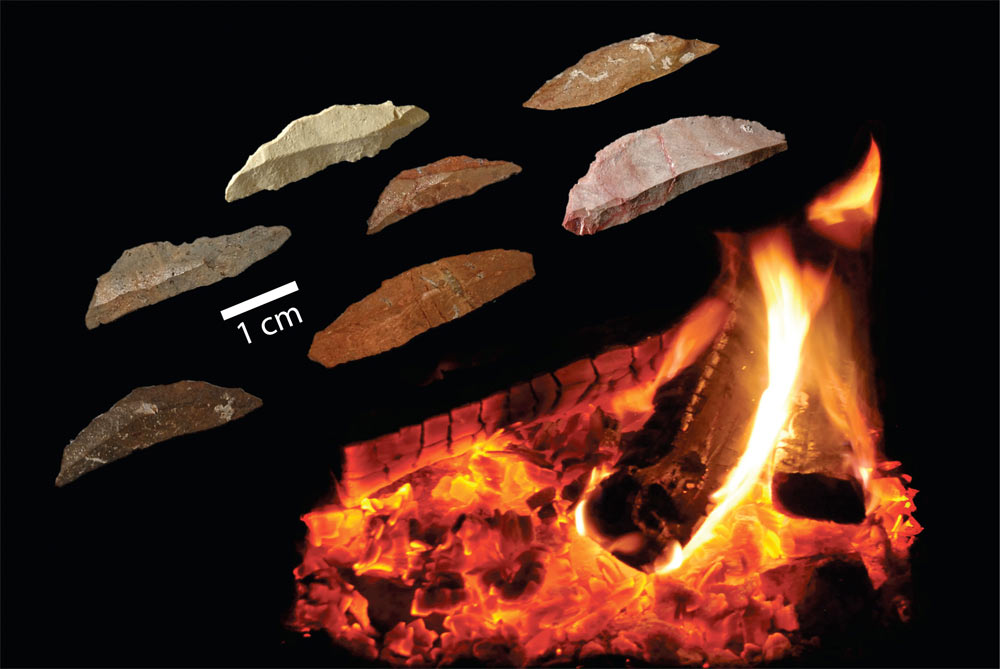Complex Tool Discovery Argues for Early Human Smarts

Rocks carved into ancient stone arrowheads or into lethal tools for hurling spears suggest humans innovated relatively advanced weapons much earlier than thought, researchers in South Africa say.
The researchers' finds, partially exposed by a coastal storm, suggest ancient peoples were capable of complex forms of thinking, scientists added.
"These people were like you and I," researcher Curtis Marean, a paleoanthropologist at Arizona State University in Tempe, told LiveScience.
The early human brain
Modern humans originated in Africa about 200,000 years ago, but when modern human ways of thinking emerged remains controversial. For instance, some researchers note that the first signs of complex thought such as art appeared relatively late in history, suggesting that genetic mutations linked with modern human behavior occurred as recently as 40,000 years ago. Other scientists argue that modern human thought originated much earlier but that the evidence was largely lost to the rigors of time. [Top 10 Mysteries of the First Humans]
One potential sign of complex thought would be an elaborately produced artifact that would have required capabilities such as language to pass along the technique to future generations.
Some have argued that advanced technologies in Africa frequently appeared and disappeared over time. Now, however, tiny stone blades discovered on the south coast of South Africa and dating back about 71,000 years suggest advanced stoneworking techniques persisted for vast spans of history instead of flickering in and out of use.
Get the world’s most fascinating discoveries delivered straight to your inbox.
"Every time we excavate a new site in coastal South Africa with advanced field techniques, we discover new and surprising results that push back in time the evidence for uniquely human behaviors," Marean said.
Continuity of history
These artifacts were discovered over the course of nine years at a site known as Pinnacle Point, in a storm-prone area with a temperate climate like San Francisco's. Initially, Marean found many artifacts and fossil bones on the beach. Then, one day, a storm exposed deposits of these materials from a cave higher up. So far the researchers have found sediments about 45 feet (14 meters) deep containing artifacts and fossils dating from approximately 50,000 to 90,000 years ago.
"As an archaeologist and scientist, it is a privilege to work on a site that preserves a near-perfect layered sequence capturing almost 50,000 years of human prehistory," said researcher Kyle Brown at the University of Cape Town, South Africa. "Our team has done a remarkable job of identifying some of the subtle but important clues to just how innovative these early humans on the south coast were."
The scientists uncovered thin blades of stone, known as microliths, each about 1.2 inches (3 centimeters) long at most. These were blunted along one edge so they could be glued onto slots carved in wood or bone. The stone used to produce these blades, silcrete (quartz grains cemented by silica), was carefully treated with heat to make it easier to shape.
These microliths could have found use as the earliest known arrowheads. However, researchers suggest they were more likely incorporated into spear-hurling devices known as atlatls. These spear-throwers were essentially sticks with spurs or cups to hold the projectile. Swinging the atlatl provided leverage to increase the distance and killing power of the hurled dart or spear.
The microliths may have served as spurs in these atlatls. [See images of the ancient tools]
"They are parts of a complex composite weapon," Marean said.
Past research suggested microlithic technology appeared briefly between 60,000 and 65,000 years ago.
"Eleven thousand years of continuity is, in reality, an almost unimaginable time span for people to consistently make tools the same way," Marean said. "This is certainly not a flickering pattern." Moreover, heat treatment of stone was seen at Pinnacle Point about 160,000 years ago, suggesting people there mastered this complex technique for nearly 100,000 years.
The researchers suggest these projectile weapons were pivotal to the success of modern humans as they left Africa and encountered Neanderthals, who apparently possessed only hand-thrown spears.
"When Africans left Africa and entered Neanderthal territory, they had projectiles with greater killing reach, and these early moderns probably also had higher levels of pro-social, hyper-cooperative behavior. These two traits were a knockout punch. Combine them, as modern humans did and still do, and no prey or competitor is safe," Marean said. "This probably laid the foundation for the expansion out of Africa of modern humans and the extinction of many prey as well as our sister species such as Neanderthals."
The flickering pattern seen previously with such technologies is likely due to the relatively small number of well-excavated sites in Africa, he said.
"This is why continued and well-funded fieldwork in Africa is of the highest scientific priority if we want to learn about what it means to be human, and where and when it happened," Marean said.
It remains uncertain how exactly these microliths were used, since the material they were mounted onto has apparently rotted away over time. "We need to determine exactly how the microliths were mounted and to what," Marean said. "That will be very hard to do."
The scientists detailed their findings online Nov. 7 in the journal Nature.
Editor's Note: This story has been updated with a corrected byline.
Follow LiveScience on Twitter @livescience. We're also on Facebook & Google+.



